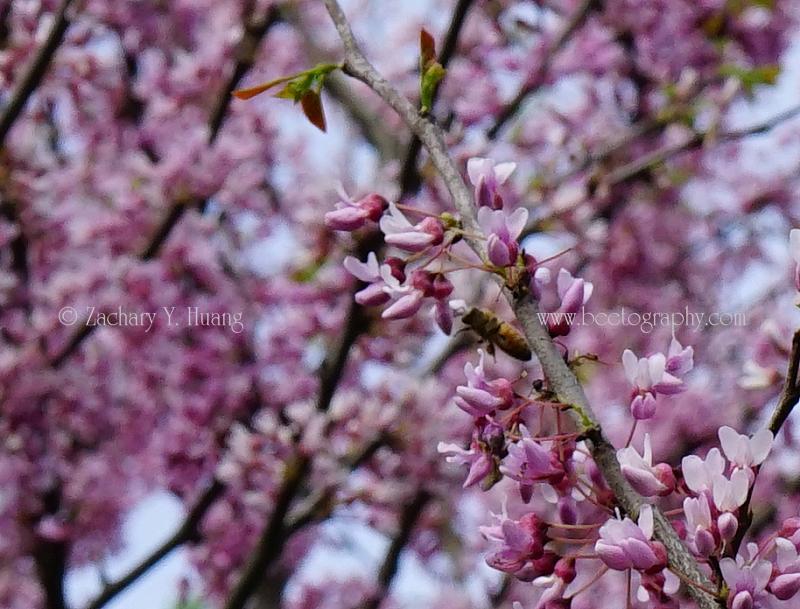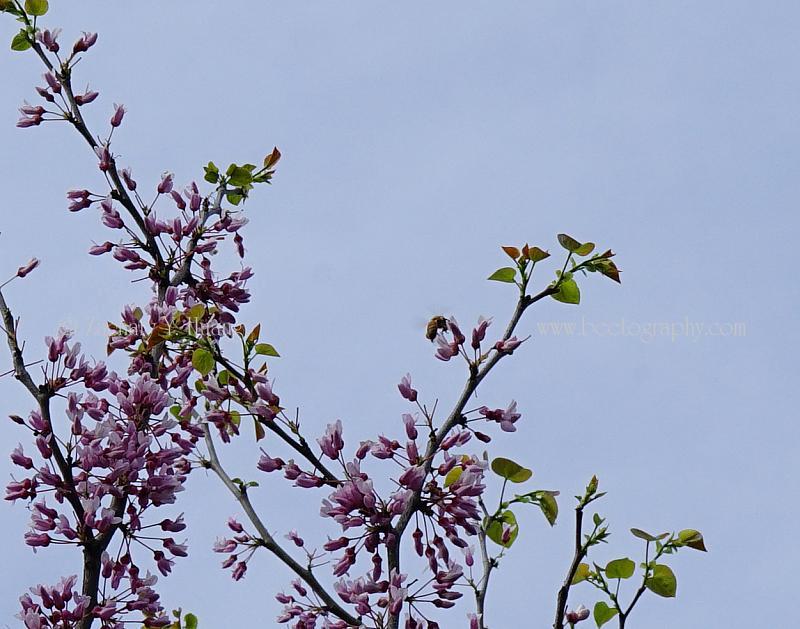| Family | Fabaceae |
| Genus | Cercis |
| Species | C. chinensis |
| ZBAS | 8 [C. chinensis.] 1 [C. canadensis] |
Eastern redbud trees are blooming, one right in front of the building where my lab and office are located, the Giltner Hall.
Eastern redbud is a legume (Fabaceae), named Cercis canadensis, (so technically it should be called Canadian redbud!). Wiki says “The flowers are pollinated by long-tongued bees such as blueberry bees and carpenter bees. Short-tongued bees apparently cannot reach the nectaries.” Although I am not sure if Michigan has these “blueberry bees” (Osmia atriventris), I have indeed trying to observe, wait and pray, a honey bee would show up so I can snap a nice photo of them; to no avail. Because the flowers are pretty in the spring!
I have seen bumble bees and solitary bees on these flowers but not a honey bee yet. Then in Australia, in one botanic garden, I did see a honey bee visiting this flower. I remember (if correctly) that the tree was the same species, Cercis canadensis.
Then in China, May of 2012, I saw many bees visiting a redbud tree — they looked almost the same as our trees here. But some research turned out that it is a different species: the Chinese redbud, Cercis chinensis. I am sure I also have taken photos of Apis mellifera foraging on this species, the photos I found on April 2, 2012, are only of Apis cerana, which is the sister species of our bees. Because the Asian honey bees are slightly smaller than our bees (5-40% smaller, depending on location), I assume they should have shorter tongues too, so the Chinese redbuds must have much shorter flower tubes or unless the bees are only foraging for pollen. I need to dissect some flowers of ours to see if our bees can reach their pollen or not.
1. An eastern redbud tree at MSU. This one has a halictid bee (Halictidae) foraging on it. You would think honey bees should have similar tongue length? Shot April 29, 2007. Nikon D80, 70-300mm lens at 300mm. So she must be really high up on the tree.

2. A close up of the same bee, perhaps. She has lots of pollen on her legs. She must also have pollen baskets?

3. The first honey bee I saw on redbud tree flowers, in Australia. I assume it is the same species as ours.
4. Now the Chinese redbud. The flowers seems to be slightly more purple. But it would be just my camera was not white balanced correctly.
5. A closer look at the flowers. You can see one bee near the center.
6. An Asian honey bee (Apis cerana) on Chinese redbud tree flowers.
7. She is loaded with pollen, I assume she is trying to reach the nectar also here. But without seeing her tongue (proboscis), it is difficult to tell. She could also just trying to bite the anthers to release pollen.
8. A hovering bee.
In summary, it seems the Chinese redbud tree may play a role in providing at least pollen to honey bees (I thought I have also Apis mellifera foraging on them, but today I tried my best and did not find them. So I conclude I have one single photo of a A. mellifera on redbud!), but for our species here, it does not attract honey bees.
[update] This year I finally saw 4-5 honey bees foraging on a tall tree near my Okemos yard. I managed to look carefully and found two honey bees in my photos. My 180 mm macro is not enough. I will try 300mm next year :)
9. This is clearly a honey bee. Taken May 23, 2020.

10. This should also be a honey bee. Even smaller, at least 6 meters away.

References:
Wiki, 2014. Cercis canadensis. http://en.wikipedia.org/wiki/Cercis_canadensis. Accessed May 12, 2014.
Wiki, 2014. Cercis chinensis. http://en.wikipedia.org/wiki/Cercis_chinensis. Accessed May 12, 2014.
Original post: May 12, 2004
Updated: June 3, 2020.

